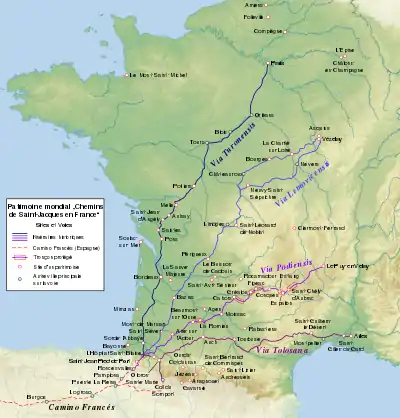| UNESCO World Heritage Site | |
|---|---|
 | |
| Location | France |
| Includes | 71 structures (churches, abbeys, etc) and 7 stretches of road |
| Criteria | Cultural: (ii), (iv), (vi) |
| Reference | 868 |
| Inscription | 1998 (22nd Session) |
| Area | 97.21 ha (240.2 acres) |
| Coordinates | 45°11′2.6″N 0°43′22.6″W / 45.184056°N 0.722944°W |
.svg.png.webp) Location of Routes of Santiago de Compostela in France in Earth | |
UNESCO designated the Routes of Santiago de Compostela in France as a World Heritage Site in December 1998. The routes pass through the following regions of France: Aquitaine, Auvergne, Basse-Normandie, Bourgogne, Centre, Champagne-Ardenne, Ile-de-France, Languedoc-Roussillon, Limousin, Midi-Pyrénées, Picardie, Poitou-Charentes, and Provence-Alpes-Côte d'Azur.[1] UNESCO cites the routes' role in "religious and cultural exchange", the development of "specialized edifices" along the routes, and their "exceptional witness to the power and influence of Christian faith among people of all classes and countries in Europe during the Middle Ages".[1]
UNESCO designated 71 structures along the routes and seven stretches of the Chemin du Puy as a World Heritage Site. The structures are largely monuments, churches, or hospitals that provided services to pilgrims headed to Santiago de Compostela in Spain. Some are places of pilgrimage in their own right. Other structures include a tower, a bridge, and a city gate.[2]
Structures
The sites included in the UNESCO designation are largely monuments, churches, or hospitals that provided services to pilgrims headed to Santiago de Compostela in Spain. Some are places of pilgrimage in their own right. Other structures include a tower, bridges, a city gate, and a prehistoric stone construction.[2] When UNESCO designates monuments as World Heritage Sites, this often leads to an increase in tourism that challenges the abilities of local communities to continue protecting the sites themselves.[3]
Auvergne-Rhône-Alpes
- Clermont-Ferrand: church Notre-Dame du Port
- Le Puy-en-Velay: cathedral
- Le Puy-en-Velay: Hôtel-Dieu Saint-Jacques
Bourgogne-Franche-Comté
- La Charité-sur-Loire: church Sainte-Croix-Notre-Dame
- Asquins: church Saint-Jacques d'Asquins
- Vézelay: former abbatial church Sainte-Madeleine
Centre-Val de Loire
- Neuvy-Saint-Sépulchre: collegial church Saint-Étienne (formerly collegial church Saint-Jacques) – Centre-Val de Loire
- Bourges: cathedral Saint-Étienne – Centre
Grand Est
- L'Épine: Basilica Notre-Dame de l'Épine
- Châlons-en-Champagne: church Notre-Dame-en-Vaux
Hauts-de-France
- Amiens: cathedral Notre-Dame
- Compiègne: parochial church Saint-Jacques
- Douai: Église Saint-Jacques de Douai
- Folleville: parochial church Saint-Jean-Baptiste
Île-de-France
Normandy
Nouvelle-Aquitaine
- Périgueux: cathedral Saint-Front
- Saint-Avit-Sénieur: church
- Le Buisson-de-Cadouin: former abbaye
- Bazas: former cathedral
- Bordeaux: basilica of St. Severinus
- Bordeaux: basilica of St. Michael
- Bordeaux: cathedral of St. Andrew
- La Sauve: abbey de La Sauve-Majeure
- La Sauve-Majeure: church Saint-Pierre
- Soulac-sur-Mer: church Notre-Dame-de-la-Fin-des-Terres
- Aire-sur-l'Adour: church Sainte-Quitterie
- Mimizan: bell tower
- Sorde-l'Abbaye: abbey Saint-Jean
- Saint-Sever: abbey
- Agen: cathedral Saint Caprais
- Bayonne: cathedral Sainte-Marie
- L'Hôpital-Saint-Blaise: church
- Saint-Jean-Pied-de-Port: gate Saint Jacques
- Oloron-Sainte-Marie: church Sainte Marie
- Saintes: church Sainte-Eutrope
- Saint-Jean-d'Angély: royal abbey Saint-Jean-Baptiste
- Melle: church Saint-Hilaire
- Aulnay: church Saint-Pierre
- Poitiers: church Saint-Hilaire-le-Grand
- Pons: former hospital des Pèlerins
- Saint-Léonard-de-Noblat: church Saint-Léonard
Occitanie
- Saint-Guilhem-le-Désert: former abbey de Gellone
- Aniane/Saint-Jean-de-Fos: Pont du Diable
- Saint-Gilles-du-Gard: former abbatial church
- Audressein: church of Tramesaygues
- Saint-Lizier: former cathedral and cloister, cathedral Notre-Dame-de-la-Sède, episcopal palace, rempart
- Conques: Abbey Church of Saint Foy
- Conques: bridge over the Dourdou
- Espalion: Pont-Vieux
- Estaing: bridge over the Lot
- Saint-Chély-d'Aubrac: bridge called "des pèlerins " over the Boralde
- Saint-Bertrand-de-Comminges: former cathedral Notre-Dame
- Saint-Bertrand-de-Comminges: paleo-Christian basilica, chapel Saint-Julien
- Toulouse: basilica Saint-Sernin
- Toulouse: Hôtel-Dieu Saint-Jacques
- Valcabrère: church Saint-Just
- Auch: cathedral Sainte-Marie
- Beaumont-sur-l'Osse and Larressingle: Pont d'Artigue or of Lartigue
- La Romieu: collegial church Saint-Pierre
- Cahors: cathedral Saint-Étienne
- Cahors: Valentré Bridge
- Gréalou: dolmen of Pech-Laglaire
- Figeac: hospital Saint-Jacques
- Rocamadour: church Saint-Sauveur and crypt Saint-Amadour
- Aragnouet: hospice of the Plan and chapel Notre-Dame- de-l'Assomption, aka. chapelle des Templiers
- Gavarnie: parochial church
- Jézeau: church Saint-Laurent
- Ourdis-Cotdoussan: church of Cotdussan
- Rabastens: church Notre-Dame-du-Bourg
- Moissac: abbey-church Saint-Pierre and cloister
Provence-Alpes-Côte d'Azur
- Arles: Église Saint-Honorat
References
- 1 2 "Routes of Santiago de Compostela in France". UNESCO. Retrieved 15 August 2015.
- 1 2 "Routes of Santiago de Compostela in France (maps)". UNESCO. Retrieved 15 August 2015.
- ↑ Dosquet, Frédéric; Lorey, Thierry; Bourliataux-Lajoinie, Stéphane; del Olmo Arriaga, Josep Lluís (2020), Séraphin, Hugues; Gladkikh, Tatiana; Vo Thanh, Tan (eds.), "Case Study 5: A Paradox of the UNESCO "World Heritage" Label? The Case of the Way of St James of Compostela in France", Overtourism, Cham: Springer International Publishing, pp. 267–284, doi:10.1007/978-3-030-42458-9_15, ISBN 978-3-030-42457-2, retrieved 2023-09-14

